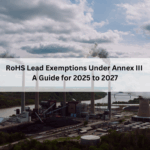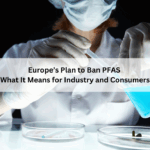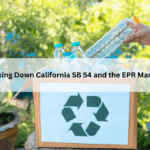A new amendment to Regulation (EC) No 1907/2006 (REACH) is set to take effect on 8th May 2023. This amendment is aimed at eliminating lead (lead acetate) and its compounds from PVC (polyvinyl chloride) and other plastics. In addition to being a toxic substance, lead can also be harmful to the environment and to humans. The material is commonly used in the manufacturing of PVC to improve thermal stability and protect against photo-degradation.
The amendment is expected to reduce the production and use of lead in PVC and other plastics, resulting in a safer environment and fewer health risks. Companies that manufacture PVC will need to find alternatives to lead to comply with the law.
It has been shown that the presence of lead in PVC poses a risk to human health as well as the environment. Lead is a known neurotoxin that can cause a range of health issues, from headaches and irritability to seizures and even death. It can also accumulate in the environment, leading to pollution of the air, water, and soil. As a result, it is important to limit the use of PVC that contains lead. Therefore, the European Commission decided that PVC materials should be restricted in their lead content.
The Commission Regulation (EU) 2023/923, which was issued on 3 May 2023, adds six points to Annex XVII, entry 63 of REACH, wherein the restrictions on lead and its compounds in PVC are specified. The amendment states that articles containing PVC that contain a lead concentration equal to or greater than 0.1% by weight shall not be placed on the market if they contain that amount of lead. Under certain conditions and within certain timeframes, PVC articles that contain recovered flexible PVC or recovered rigid PVC are eligible to receive benefits. Such benefits include exemptions from the lead concentration limit, as well as derogations allowing the marketing of recovered PVC articles with a lead concentration equal to or greater than 0.1% by weight. Additionally, adequate information must be provided to enable the safe use and disposal of such articles.
According to the new restrictions, the aim is to reduce human exposure to lead as well as minimize its impact on the environment. As a result of the regulation restricting the use of lead in PVC, it contributes to the protection of human health, especially during product usage and at the end of its life cycle. Moreover, it encourages the development of safer and more sustainable alternatives to PVC-containing materials that are more environmentally friendly.
The REACH amendment imposes restrictions on lead concentration in PVC materials. It prohibits the placement of articles with a lead concentration of 0.1% or higher on the market. Certain exceptions and transitional periods are provided for PVC articles containing recovered flexible and rigid PVC. The regulation aims to mitigate lead exposure risks and promote safer materials.
ComplianceXL provides the necessary support and guidance for organizations to achieve full compliance. Organizations must also ensure that they are up to date with the latest changes in the regulation. Compliancexl offers expert advice and guidance to help organizations stay compliant with the latest regulations.
FAQs
Q: What is the purpose of the lead restrictions in PVC?
A: The restrictions aim to protect human health and the environment from the harmful effects of lead, which is commonly used in PVC for thermal stability and protection against photo-degradation.
Q: When do the new restrictions come into effect?
A: The restrictions apply from 29 November 2024 for most PVC articles. However, there are exceptions and transitional periods for PVC articles containing recovered flexible PVC and recovered rigid PVC.
Q: How will suppliers prove the origin of recovered PVC?
A: Suppliers of PVC articles containing recovered rigid PVC must provide documentary evidence to substantiate claims of the recovered origin of the PVC. Certificates issued by recognized schemes or independent third parties can be used for this purpose.





